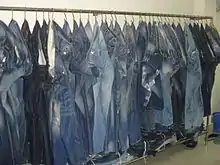Ready-made garment
Ready-made garments are mass-produced finished textile products of the clothing industry. They are not custom tailored according to measurements, but rather generalized according to anthropometric studies. They are made from many different fabrics and yarns.[1] Their characteristics depend on the fibers used in their manufacture.[2] Ready-made garments are divided into the following types: outer clothing, which includes workwear and uniforms, leisure wear, and sportswear (e.g., suits, pants, dresses, ladies' suits, blouses, blazers, jackets, cardigans, sweaters, coats, sports jackets, skirts, shirts, ties, jeans, shorts, T-shirts, polo shirts, sports shirts, tracksuits, bathing shorts, bathing suits, and bikinis); and undergarments, which include jersey goods and lingerie (e.g. underpants, undershirts, briefs, socks, stockings, and pantyhose).

History
The first ready-made garment factory was established in New York in 1831. During the American Civil War the need for ready-made uniforms helped the garment sector grow in the United States.[3] Near the end of the nineteenth century there were changes in societal views towards ready-made garments: They were no longer seen as only for the lower classes but also for the middle classes. This trend started in the United States. In the beginning they were more popular with men than women.[4] In the late 1860s, twenty-five percent of garments produced in the US were ready-made, but by 1890, the portion had risen to sixty percent. By 1951, ninety percent of garments sold in the United States were ready made. During the same time two-thirds of garments sold in France were ready made.[5]
See also
References
- "Ready-made garments". www.tis-gdv.de. Retrieved 5 May 2016.
- Abul Basher (26 June 2009). "The important role of ready made garments to Bangladesh's export earnings". worldbank.org. World Bank. Retrieved 18 January 2017.
- editor, Eric Arneson (2007). Encyclopedia of U.S. labor and working-class history. New York: Routledge. p. 496. ISBN 9780415968263. Retrieved 23 July 2015.CS1 maint: extra text: authors list (link)
- Aindow, Rosy (2010). Dress and identity in British literary culture, 1870-1914. Farnham, Surrey: Ashgate. p. 37. ISBN 978-0754661450. Retrieved 23 July 2015.
- Green, Nancy L. (1997). Ready-to-wear and ready-to-work : a century of industry and immigrants in Paris and New York. Durham: Duke University Press. p. 118. ISBN 0822318741. Retrieved 23 July 2015.